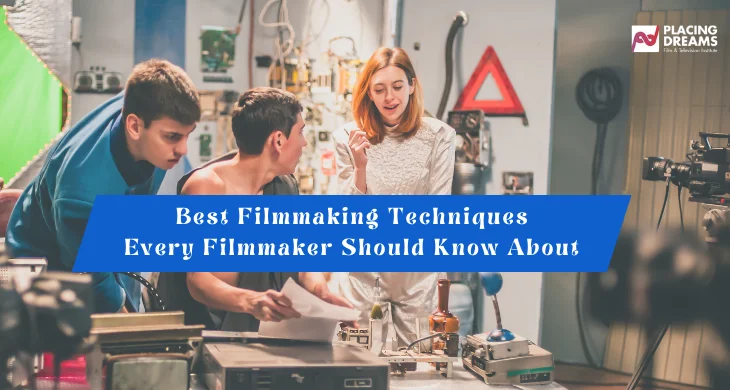From silent, black-and-white films to the colorful, high-definition productions we see today, filmmaking has gone a long way. But one thing remains constant: the power of storytelling.
Filmmaking is an art, and each artist has unique methods. However, some techniques are essential and common to all. This article dives into the essential techniques every filmmaker, from beginner to professional, should have in their toolbox. By mastering these filmmaking techniques, you’ll be well on your way to crafting compelling visuals and narratives that resonate with your viewers.
Which Techniques Are Important for Every Filmmaker to Know?
1. Camera Techniques and Development of the Tripod
Camera angles and techniques are critical to a filmmaker’s work. This is an important producer-focused method of filming. Always shoot every scene using classic shot framing and camera angles to ensure there is scene coverage in post-production. Use a tripod for essential shots and use pan and tilt movements to follow the action when it makes sense. A tilt and pan can give your scene a sense of movement and ease. Always ensure the shot composition and lighting direct the audience’s eyes to the important part of the frame.
2. A Story to Illustrate
A common mistake for filmmakers is not having a clear and structured story. This technique is crucial because if the story lacks the drama and power the audience is looking for, the film won’t succeed. It is necessary to take audiences on an emotional journey. A character in a novel must have a purpose, and the drama arises from the obstacles they must overcome to get it. Write a story that focuses on action and fits within your film’s budget.
3. Make a Production Plan
The chosen colors and styles convey information about the characters and the story. The “look book” technique involves creating a production design that includes images and drawings of the look and feel for each scene. A movie’s appearance will help to sell its reality. Locations, sets, props, furniture, vehicles, costumes, and makeup all contribute to a cohesive design.
4. Lighting Strategies
Lighting conveys the mood of a character or tells something about their worldview. Lighting techniques can also help focus attention. High-key lighting is a style that reduces shadows on your subject. It is typically created using two large light sources and is cheaper compared to other methods.
5. Utilize Proper Music
Films need breathing room between music cues. Adding music throughout the entire film might work, but it could feel like a music video. This is a significant technique for producers and directors. Use music when it counts. Too much music can dull its impact. Music with vocals can compete with the characters’ dialogue. Producers also need the proper licenses to use any popular song in their film.
6. Keep Sound Over Visuals
Audiences will forgive a shot that isn’t well lit, slightly out of focus, or shaky, but they won’t tolerate bad sound. Music and sound effects are usually secondary to dialogue. Sometimes music may overshadow sound effects, or sound effects might overshadow music, depending on the scene. A minimal amount of compression can be used to ensure the dialogue stands out over the music and sound effects.
Filmmaking is a complex endeavor, requiring a harmonious blend of storytelling ingenuity and technical finesse. Mastering essential techniques lays the foundation for creative exploration, resulting in cinematic experiences that transcend mere visual spectacle. If you aspire to hone your filmmaking skills, consider enrolling in the comprehensive courses offered by PLACING DREAMs.
Explore Our Courses:
ALSO READ | 16 Must-Read Filmmaking Books to Enhance Your Skills
Conclusion
If you’re truly committed to mastering these techniques and forging a path as a filmmaker, take the next step in your journey by signing up for one of the courses offered by PLACING DREAMs. As one of the premier filmmaking schools in India, we equip our students with cutting-edge technology to help them become industry-ready. Let your passion for filmmaking soar as you embark on an extraordinary educational experience with us.
FAQs
Que: What skills are required to become a proficient video editor?
Ans: To become a proficient video editor, you need a mix of technical skills (like mastering editing software), creativity, attention to detail, and good communication skills to collaborate with directors and other team members.
Que: How can PLACING DREAMs help me learn Video Editing?
Ans: PLACING DREAMs offers specialized courses in video editing that cover both the technical aspects and creative techniques. Our programs provide hands-on experience with real projects, guided by industry professionals.
Que: Will I get hands-on experience with real projects during the training?
Ans: Yes, at PLACING DREAMs, our courses are designed to provide hands-on experience with real projects, ensuring that you gain practical skills and a solid portfolio.
Que: Is there any placement assistance provided for Video Editing graduates?
Ans: Yes, PLACING DREAMs provides placement assistance to help our graduates find opportunities in the film industry. We have a strong network of industry contacts to support your career aspirations.

